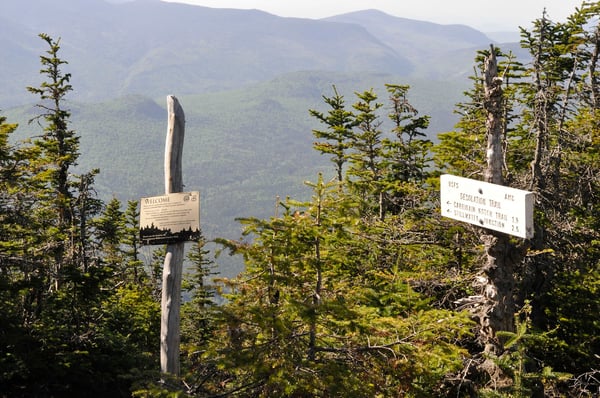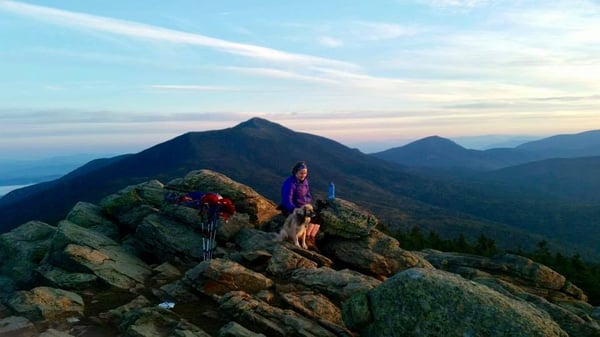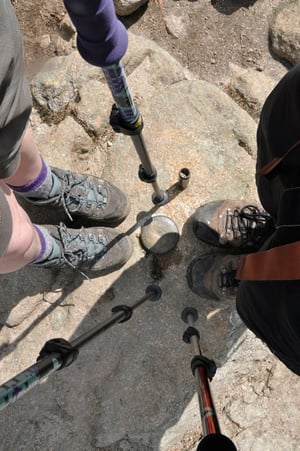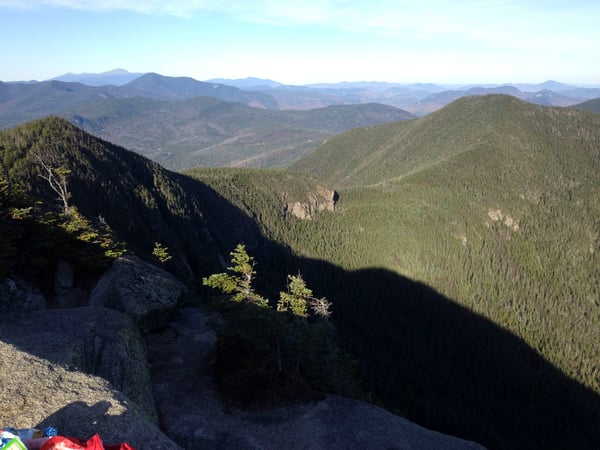The White Mountains of New Hampshire are home to some of the toughest mountain peaks on the East Coast. While the peaks might not be as high as similar peaks out west, the weather and terrain are notoriously challenging.
This blog post is part of “The Guide to Summer Activities In The White Mountains” blog series.
In fact, on April 12, 1934, Mount Washington set a world record for the fastest wind gust ever recorded on the surface of the Earth at 231 miles per hour. Many of the country’s top outdoor apparel companies will often test their equipment in the White Mountains.
With that being said, plan ahead and be prepared for hiking in the White Mountains.
Mount Washington isn’t the only mountain in the White Mountains for advanced hikers. The White Mountains is home to 48 4,000-footers that are popular with hikers from all across New England. With so many incredible mountain peaks that can be hiked year-round, a weekend or two every year just isn’t enough. However, to get you started, we’ve provided our favorite advanced hikes for you to enjoy.
Mount Washington
Mount Washington is perhaps the crown jewel of the White Mountains. Standing at 6,288 feet, Mount Washington is the highest mountain peak east of the Mississippi River and north of North Carolina. Every year, the famous peak attracts thousands of people who summit its peak by foot, car, or bicycle.
Known for its temperamental weather, Mount Washington is a challenging hike not only because of its difficult terrain, but also its weather. Even in the height of summer, the weather on Mount Washington has been known to change at a drop of a pin. When hiking Washington, you’ll want to pack for all seasons, including snow in July. Yes, you read that correctly.
 Tuckerman Ravine Trail on the east side of the mountain is the most popular and easiest (but still very strenuous) trail to the summit. Over the course of 7.9 miles, you’ll gain about 4,169 feet in elevation making it a challenging trail for even those in good shape. The last push to the summit is often a bit more of a rock climb than a hike. However, once you reach the top, you’re rewarded with fantastic panoramic views. If you run out of water or need to refuel, the visitor’s center at the top sells food depending on the season.
Tuckerman Ravine Trail on the east side of the mountain is the most popular and easiest (but still very strenuous) trail to the summit. Over the course of 7.9 miles, you’ll gain about 4,169 feet in elevation making it a challenging trail for even those in good shape. The last push to the summit is often a bit more of a rock climb than a hike. However, once you reach the top, you’re rewarded with fantastic panoramic views. If you run out of water or need to refuel, the visitor’s center at the top sells food depending on the season.
Boott Spur Trail is another popular option for hiking Mount Washington. This 5.7-mile out-and-back trail offers incredible views of the surrounding mountains and tons of wildflowers. Many hikers will often ascend Tuckerman Ravine and descend the mountain via less crowded Boot Spur.
For those who are looking to avoid the rock scramble at the top of Tuckerman Ravine, the Lion Head Trail is a great alternative. At about 3,825 feet, you’ll come to a trail junction where you’ll take Lion Head along Tuckerman Ravine’s north rim before rejoining the trail shortly before the summit. The Lion Head Trail is the most popular winter ascent route as it is much easier than Tuckerman Ravine. Lion Head Trail can also be combined with Boot Spur Trail for a 9.6-mile loop trail.
Presidential Traverse

If summiting Mount Washington isn’t enough for you, then you might want to consider the epic Presidential Traverse, a 23-mile, 9,000-feet elevation gain hike that will undoubtedly earn you bragging rights. Many of the mountain peaks in the White Mountain National Forest and surrounding landscape are named after past presidents, hence the name Presidential Traverse.
The popular Presidential Traverse includes ten 4,000+ foot peaks (8 that are considered part of the 48), including the five highest peaks in the White Mountains. Most hikers will hike the Traverse from north to south to hike the highest elevations early on. While the Traverse can be done in a single day, many hikers will make a weekend of it to enjoy the incredible views and enjoy the experience.
The Presidential Traverse is no easy feat, especially for the brave few who opt to do it in the winter. The hike is almost entirely above treeline where you’re constantly being exposed to the elements – sun, rain, lightning, hail, and even snow. If you’re looking to bag peaks in one hike with epic views of the White Mountains, look no further than the Presidential Traverse. It’s truly one of the best hikes in the East.
Franconia Ridge Loop

Rated as one of the best hikes in the world by National Geographic author, Jonathan Waterman, the Franconia Ridge Loop is a beautiful nine-mile, seven-hour traverse of Mount Lafayette, Mount Lincoln, and Little Haystack mountains in Franconia Notch State Park. Mount Lafayette is the highest mountain peak outside of the Presidential Range.
The summer and fall months are by far the best times to hike the scenic loop as the views are incredible. The trail stays above treeline for over a mile and a half, so you’ll want to bring your camera. Most hikers will ascend the Falling Waters Trail, but the Old Bridle Path offers the best views and is slightly less crowded.
Since much of the trail is above treeline, expect temperamental weather. One second it might be 75 and sunny. The other foggy with 40 mph wind. If you’re lucky to ascend Mount Lafayette on a bluebird day, you are rewarded with 360-degree of the surrounding mountains. The Franconia Ridge Loop is dog-friendly as long as your four-legged friend is on a leash.
Plan accordingly, this is a very popular hike and parking is limited.

The 4,000-Footers
The White Mountains are home to 48 4,000+ foot mountains. While it’s easy to check off multiple 4,000-footers with the Presidential Traverse or the Franconia Ridge Loop, not everyone as the time or energy for a long hike. Sometimes, you just want to hike one mountain, and there is nothing wrong with that.
Located within scenic Franconia Ridge, Mt. Liberty standing at 4,459 feet is the closest 4,000-footer to Lincoln. The summit, which is a rocky peak, can be reached by the Liberty Spring Trail, which is part of the much longer Appalachian Trail. The trail is very strenuous with hundreds of rock stairs, but the views are worth the climb.
Mt. Bond is another 4,000-footer located near Lincoln standing at 4,698 feet. It’s the highest mountain peak in the southern Twin range and one of the most remote peaks in all of the White Mountains. From the summit, you’ll see no roads or buildings. It’s truly spectacular!
Due to its remoteness, Mt. Bond is a strenuous trek. The best route to the trailhead is by the 2.9-mile Lincoln Woods Trail to the Bondcliff Trail. The hike to the top is about 10 miles one-way. Many hikers will opt to make the hike a multi-day adventure and summit neighboring 4,560-foot Mt. Guyot before descending the following day.
The Views are Worth the Effort

Many of the best hiking trails in the White Mountains will make you work for it. With steep, rocky, and above tree line trails, many of the trails are reserved for those
This blog post is part of “The Guide to Summer Activities In The White Mountains” blog series.
If you're new to hiking or you don't have the proper equipment (hiking shoes, rain gear, headlamps, water, food, etc), there are plenty of hikes that will get your heart rate pumping and reward you with spectacular views and waterfalls without risking your safety and the safety of others. The White Mountains have hikes for all different abilities and elevation levels.
For more information on hiking safety, hiking gear checklists and more visit HikeSafe.com.
Plan your summer hiking adventure now before local resorts are booked for the season!


